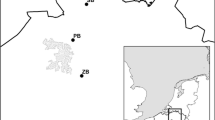Abstract
The aim of this study was to quantify the infestation densities of Karoo and brown paralysis ticks on sheep and goats and explain it in terms of the etho-ecology of these ticks and their domestic hosts. The Karoo paralysis tick usually quests from a vantage point on the vegetation whereas the brown paralysis tick displays an appetence response from the ground and mainly engages hosts that are prostrate. Both tick species are confined chiefly to hilly areas. Temporal differences in the infestation densities of the hosts within and between tick species were evident. These differences were related to disparities in the spatial distribution of the hosts, their activity patterns and the specific appetence responses of the two tick species. Differential climatological conditions affected the quality of forage in areas with a varied topography and the feeding preferences of hosts influenced tick-host sympatry and hence infestation densities.
Similar content being viewed by others


References
Acocks, J.P.H., 1975. Veld types of South Africa with accompanying veld type map. Mem. Bot. Surv. S. Afr., 40: 1–128.
Altmann, J., 1974. Observational study of behaviour: sampling methods. Behaviour, 49: 227–267.
Barnard, D.R., 1989. Habitat use by cattle affects host contact with Lone Star Ticks (Acari: Ixodidae). J. Econ. Entomol., 82: 854–859.
Bennett, G.F., 1969.Boophilus microplus (Acarina: Ixodidae): Experimental infestations on cattle restrained from grooming. Exp. Parasitol., 26: 323–328.
Cooksey, L.M., Davey, R.B., Ahrens, E.H. and George, J.E., 1989. Suitability of white-tailed deer as hosts for cattle fever ticks (Acari: Ixodidae). J. Med. Entomol., 26: 155–158.
De Jager, C., 1988. Water- and energieverhoudings by die Karooverlammingsbosluis,Ixodes rubicundus Neumann, 1904 (Acari: Ixodidae). M.Sc. thesis, University of the Orange Free State, Bloemfontein, 172 pp.
De Waal, H.O., 1986. Die voedingswaarde van veldweiding van die Sentrale Oranje Vrystaat vir lakterende skape met spesiale verwysing na die rol van aanvullende energie en ruproteïen. Ph.D. thesis, University of Stellenbosch, 284 pp.
Fourie, L.J. and Horak, I.G., 1987. Tick-induced paralysis of Springbok. S. Afr. J. Wildl. Res., 17: 131–133.
Fourie, L.J. and Horak, I.G., 1991. The seasonal activity of adult ixodid ticks on Angora goats in the South-Western Orange Free State. J. S. Afr. Vet. Assoc., 62: 104–106.
Fourie, L.J. and Van Zyl, J.M., 1991. Interspecific variations in attachment sites and density assessment in femaleIxodes rubicundus (Acari: Ixodidae) on domestic and natural hosts. Exp. Appl. Acarol., 13: 1–10.
Fourie, L.J. and Vrahimis, S., 1989. Tick-induced paralysis and mortality of Gemsbok. S. Afr. J. Wildl. Res., 19: 118–121.
Fourie, L.J., Horak, I.G. and Marais, L.C., 1988a. An undescribedRhipicephalus species associated with field paralysis of Angora goats. J. S. Afr. Vet. Assoc., 59: 47–49.
Fourie, L.J., Horak, I.G. and Marais, L.C., 1988b. The seasonal abundance of adult ixodid ticks on Merino sheep in the South-Western Orange Free State. J. S. Afr. Vet. Assoc., 59: 191–194.
Fourie, L.J., Petney, T.N., Horak, I.G. and De Jager, C., 1989, Seasonal incidence of Karoo paralysis in relation to the infestation density of femaleIxodes rubicundus. Vet. Parasitol., 33: 319–328.
Fourie, L.J., Kok, O.B. and Van Zyl, M., 1991a. The spatial distribution of the Karoo paralysis tickIxodes rubicundus (Acarina: Ixodidae) within a false upper Karoo veld type. Exp. Appl. Acarol., 11: 37–49.
Fourie, L.J., Horak, I.G. and Van Zyl, J.M., 1991b. Sites of attachment and intraspecific infestation densities of the brown paralysis tick (Rhipicephalus punctatus) on Angora goats. Exp. Appl. Acarol., 12: 243–249.
Hoogstraal, H., 1978. Biology of ticks. In: J.K.H. Wilde (Editor), Tick Borne Diseases and their Vectors. Proc. Inter. Conf. Edinburgh, September–October 1976, pp. 3–14.
Margolis, L., Esch, G.W., Holmes, J.C., Kuris, A.M. and Schad, G.A., 1982. The use of ecological terms in parasitology (Report of an ad hoc committee of the American Society of Parasitologists). J. Parasitol., 68: 131–133.
Matthewson, M.D., 1984. The future of tick control. A review of the chemical and non-chemical options. In: H.P. Riemann and M.J. Burridge (Editors), Impact of Disease on Livestock Production in the Tropics. Dev. Anim. Vet. Sci., 15: 559–568.
Riek, R.F., 1962. Studies on the reactions of animals to infestation with ticks. Aust. J. Agric. Res., 13: 532–550.
Roux, P., 1973. The Angora goat in successful veld management. Angora Goat Mohair J., 15: 5–13, 49.
Smithers, R.H.N., 1983. Die soogdiere van die Suider-Afrikaans substreek. University of Pretoria, Pretoria, South Africa, 734 pp.
Sonenshine, D.E., 1975. Influence of host-parasite interactions on the population dynamics of ticks. Misc. Publ. Entomol. Soc. Am., 9: 243–249.
Spickett, A.M. and Heyne, H., 1988. A survey of Karoo tick paralysis in South Africa. Onderstepoort J. Vet. Res., 55: 89–92.
Stampa, S., 1959. Tick paralysis in the Karoo areas of South Africa. Onderstepoort J. Vet. Res., 28: 169–226.
Sutherst, R.W. and Utech, K.B.W., 1981. Controlling livestock parasites with host resistance. In: D. Pimental (Editor), CRC Handbook of Pest Management in Agriculture, Vol. II. CRC Press, Boca Raton, pp. 385–407.
Sutherst, R.W., Dallwitz, M.J., Utech, K.B.W. and Kerr, J.D., 1977. Aspects of host finding by the cattle tick,Boophilus microplus. Aust. J. Zool., 25: 159–174.
Waladde, S.M. and Rice, M.J., 1982. The sensory basis of tick feeding behaviour. In: F.D. Obenchain and R.L. Galun (Editors), Physiology of Ticks. Pergamon Press, New York, NY, pp. 71–118.
Walther, F., 1964. Verhaltenstudien an der Grant Gazelle (Gazella granti Brooke, 1872) im Ngorongoro-Krater. Z. Tierpsychol. 22: 167–208.
Author information
Authors and Affiliations
Rights and permissions
About this article
Cite this article
Fourie, L.J., Kok, O.B. The role of host behaviour in tick-host interactions: a domestic host-paralysis tick model. Exp Appl Acarol 13, 213–225 (1992). https://doi.org/10.1007/BF01194937
Accepted:
Issue Date:
DOI: https://doi.org/10.1007/BF01194937


